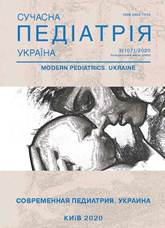Clostridium difficile infection in children and adults as a important reason of antibiotic associated diarrhea
Keywords:
C. difficile, toxin, diarrhea, NAAT, ELISA for GDH antigen detection, Vancomycin, FidoximycinAbstract
Antibiotic-associated diarrhea is a major medical problem worldwide. C. difficile is the most dangerous cause, the overgrowingn of which with the enteropathogenic toxin release is observed as a result of depletion of an intestinal microbiota, after antibiotics using. Despite an active researching of C. difficile (CDI) infection in Western countries, it diagnostics and treatment in Ukraine are underdeveloped.The aim of this article is to familiarize a wide range of physicians of various specialties with the specifics of the epidemiology, clinic, diagnosis and treatment of CDI as the most dangerous form of antibiotic-associated diarrhea.
The article highlights the risk factors for the development of CDI, the main aspects of the clinical picture, the two- and three-stage diagnostic algorithms and peculiarities of infection treatment and its relapse in adults and children.
No conflict of interest was declared by the author.
References
Burnham CA, Carroll KC. (2013, Jul). Diagnosis of Clostridium difficile infection: an ongoing conundrum for clinicians and for clinical laboratories. Clin Microbiol Rev.26(3): 604–30. https://doi.org/10.1128/CMR.00016-13; PMid:23824374 PMCid:PMC3719497
Crobach MJT, Planche Т, Eckert С, Barbut F et al. (2016, Aug). European Society of Clinical Microbiology and Infectious Diseases: update of the diagnostic guidance document for Clostridium difficile infection. Clinical Microbiology and Infection. 22;4(1): 63–81. https://doi.org/10.1016/j.cmi.2016.03.010; PMid:27460910
Delmee M, Verellen G, Avesani V, Francois G. (1988). Clostridium difficile in neonates: serogrouping and epidemiology. Eur J Pediatr. 147: 36–40. https://doi.org/10.1007/BF00442608; PMid:3338476
Gonzalez-Del Vecchio M, Alvarez-Uria A, Marin M. (2016). Clinical significance of Clostridium difficile in children less than 2 years old: a case-control study. Pediatr Infect Dis J.35: 281–285. https://doi.org/10.1097/INF.0000000000001008; PMid:26650114
Khanna S, Baddour LM, Huskins WC et al. (2013). The epidemiology of Clostridium difficile infection in children: a population-based study. Clin Infect Dis.56: 1401–1406. https://doi.org/10.1093/cid/cit075; PMid:23408679 PMCid:PMC3693491
Lubbert C, Endres John, Lutz von Muller. (2014, Oct). Clostridium Difficile Infection Guideline-Based Diagnosis and Treatment. Dtsch Arztebl Int. 111(43): 723–731. https://doi.org/10.3238/arztebl.2014.0723; PMid:25404529 PMCid:PMC4238315
McDonald L Clifford, Dale N Gerding, Stuart Johnson, Johan S Bakken et al. (1 April 2018). Clinical Practice Guidelines for Clostridium difficile Infection in Adults and Children: 2017 Update by the Infectious Diseases Society of America (IDSA) and Society for Healthcare Epidemiology of America (SHEA). Clinical Infectious Diseases. 66;7: e10e48. https://doi.org/10.1093/cid/cix1085; PMid:29462280 PMCid:PMC6018983
Nagy Elisabeth. (2018). What do we know about the diagnostics, treatment and epidemiology of Clostridioides(Clostridium) difficile infection in Europe? Journal of Infection and Chemotherapy.24;3: 164–170. https://doi.org/10.1016/j.jiac.2017.12.003; PMid:29289484
Rea MC, O'Sullivan O, Shanahan F, O'Toole P.W. et al. (2012). Clostridium difficile carriage in elderly subjects and associated changes in the intestinal microbiota. J Clin Microbiol. 50: 867–875. https://doi.org/10.1128/JCM.05176-11; PMid:22162545 PMCid:PMC3295116
Valentini D, Vittucci AC, Grandin A et al. (2013). Coinfection in acute gastroenteritis predicts a more severe clinical course in children. Eur J Clin Microbiol Infect Dis.32: 909–915. https://doi.org/10.1007/s10096-013-1825-9; PMid:23370970
What is C. diff? https://www.cdc.gov
Wilcox MH. (2012, Dec). Overcoming barriers to effective recognition and diagnosis of Clostridium difficile infection. Clin Microbiol Infect.18;6: 13020. https://doi.org/10.1111/1469-0691.12057; PMid:23121550.
Zhong Peng, Lifen Ling, Charles W, Chunhui Li et al. (2018). Advances in the diagnosis and treatment of Clostridium difficile infections. Emerging Microbes & Infections. 7;1: 1–13. https://doi.org/10.1038/s41426-017-0019-4; PMid:29434201 PMCid:PMC5837143
Downloads
Issue
Section
License
The policy of the Journal “MODERN PEDIATRICS. UKRAINE” is compatible with the vast majority of funders' of open access and self-archiving policies. The journal provides immediate open access route being convinced that everyone – not only scientists - can benefit from research results, and publishes articles exclusively under open access distribution, with a Creative Commons Attribution-Noncommercial 4.0 international license (СС BY-NC).
Authors transfer the copyright to the Journal “MODERN PEDIATRICS. UKRAINE” when the manuscript is accepted for publication. Authors declare that this manuscript has not been published nor is under simultaneous consideration for publication elsewhere. After publication, the articles become freely available on-line to the public.
Readers have the right to use, distribute, and reproduce articles in any medium, provided the articles and the journal are properly cited.
The use of published materials for commercial purposes is strongly prohibited.

